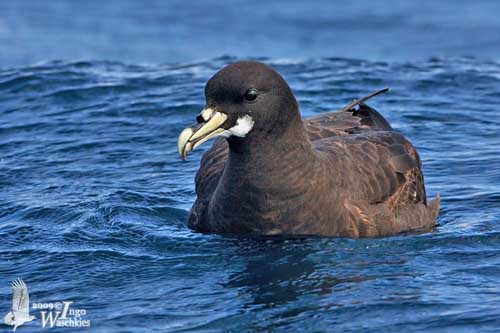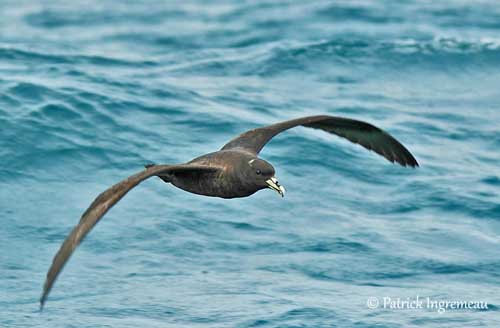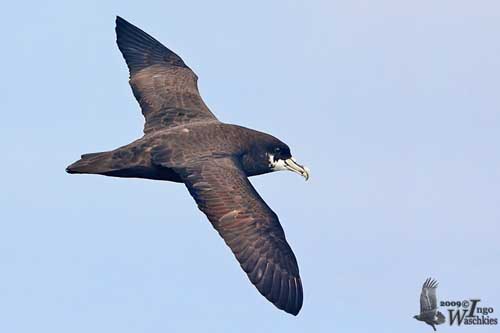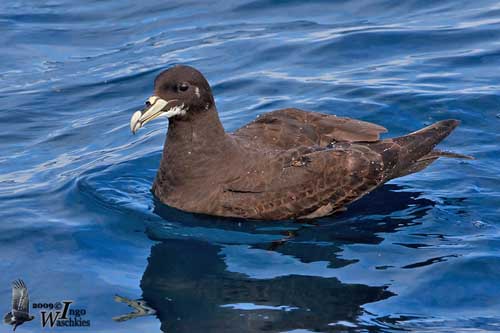
PROTECTION / THREATS / STATUS:
The White-chinned Petrel is evaluated as Vulnerable by Birdlife International.
The populations are decreasing. The commercial fisheries are an important threat and great numbers of birds are killed. The predation by cats, rats and skuas also causes loss of colonies.
Conservation measures are in progress, with elimination of introduced predators such as cats and rats from the breeding islands. Several of these islands are now protected areas.
Fr: Puffin à menton blanc
All : Weißkinn-Sturmvogel
Esp: Pardela Gorgiblanca
Ital: Procellaria mentobianco
Nd: Witkinstormvogel
Sd: Vithakad petrell
Port: pardela-preta
Photographers :
Patrick Ingremeau
TAMANDUA
Ingo Waschkies
Bird Photography
Text by Nicole Bouglouan
Sources :
HANDBOOK OF THE BIRDS OF THE WORLD vol 1 by Josep del Hoyo-Andrew Elliot-Jordi Sargatal - Lynx Edicions - ISBN: 8487334105
BirdLife International (BirdLife International)
Wildlife in the Falkland Islands
Wikipedia, the free encyclopaedia
White-chinned Petrel
Procallaria aequinoctialis
Procellariiforme Order – Procellariidae Family
BIOMETRICS:
Length: 51-58 cm
Wingspan: 134-147 cm
Weight: 1020-1420 g
DESCRIPTION:
The White-chinned Petrel is marine and pelagic. This species is one of the largest petrels. It nests in burrows in colonies.
The adult male is a bulky bird with heavily built head and neck.
It has blackish plumage overall, but in strong light, it may appear dark brown. Numerous birds show a white chin, very difficult to see in flight. But the chin often varies from white to dark.
On the underwing, the triangular wing-tips are whitish.
The bill is pale greenish with black central culmen. The eyes are dark brown. Legs and webbed feet are black.

The female is often slightly paler than male.
The juvenile resembles adults.
The race P.a. conspillata shows variable and irregular extent of white on the head.
VOICE: SOUNDS BY XENO-CANTO
The White-chinned Petrel is usually silent at sea. During the courtship displays, it utters strident calls and shrill chattering. When the entire colony is calling, there is a great volume of noise, similar to “a steel hammer tapping a small anvil”, giving the species the other names of “shoemaker” or “cobbler”.
This noise includes a succession of clacks and rattles when the birds are inside the burrows. Some wheezy and moaning calls can be heard too.
HABITAT:
The White-chinned Petrel frequents offshore waters over the continental shelf.
During the breeding season, the colonies are established on vegetated slopes, but also occasionally on flat, peaty or waterlogged grounds on sub Antarctic islands.
RANGE:
The White-chinned Petrel occurs in Falkland Islands and South Georgia, eastwards through S Indian Ocean to Campbell and Antipodes Islands.
The race “conspicillata” is found on Inaccessible Island in the Tristan da Cunha archipelago.

BEHAVIOUR:
The White-chinned Petrel feeds primarily on cephalopods, fish and crustaceans. It also follows the ships for refuse and offal. These birds perform short trips to the surrounding shelf, but long foraging trips also occur according to the range
This species feeds by surface-seizing, shallow dives but also deep plunging of up to 10 metres.
The most part of breeding activity between mates takes place inside the burrow. The courtship displays are very simple, consisting mainly of “billing” and mutual preening. They perform some noise, series of clacks and rattles inside the burrow.
The White-chinned Petrel disperses widely over Southern Atlantic, Pacific and Indian Oceans. It follows the cold waters of Humboldt and Benguala currents.
FLIGHT:
The White-chinned Petrel has large wings and is a good flier. It uses both flapping flight and glides.
This species tends to have more laboured flight when the wind is lacking, but in strong winds, it rapidly glides along with successive rising and falling.

REPRODUCTION:
The breeding season usually starts in October to mid-November, and the birds return to the breeding colonies in late September.
The White-chinned Petrel nests in burrow, excavated in soft soil below tussocks of grasses. Such burrow may be up to two metres long. The nest-chamber includes a dry platform of earth and vegetation.
The female lays only one egg after a period of abundant feeding. Both parents incubate during 57-62 days, with stints of several days, between 1 and 19. But they often leave the egg for foraging during some days.
The downy chick is dark brown. It is brooded only for few hours. The young fledge about 87-106 days after hatching. When the chick is fully-feathered, the adults stop their visits. It has to learn how to feed itself, and leaves the burrow some days later to reach the sea.
DIET:
The White-chinned Petrel feeds on cephalopods (Histiotenthis and Kondakovia), fish and crustaceans.
It also follows the ships for offal and refuse.
